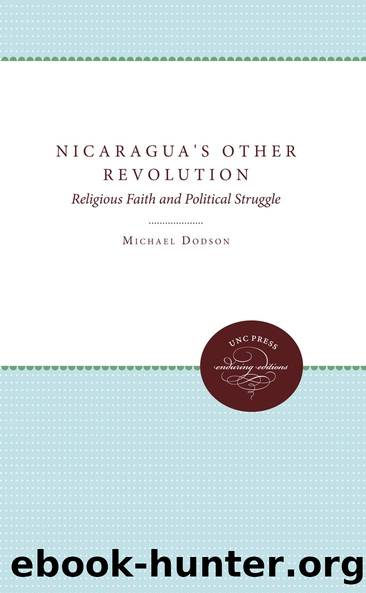Nicaragua's Other Revolution by Michael Dodson Laura Nuzzi O'Shaughnessy

Author:Michael Dodson, Laura Nuzzi O'Shaughnessy [Michael Dodson, Laura Nuzzi O'Shaughnessy]
Language: eng
Format: epub
Tags: History, Latin America, Central America
ISBN: 9780807861066
Google: ye9ECQAAQBAJ
Publisher: Univ of North Carolina Press
Published: 2000-11-09T02:56:53+00:00
Part Three: Religion at the Center of Revolutionary Struggle
The Christian church began as a sectarian movement in the ancient world. Although it spread rapidly throughout Roman territory in the first generations after Jesusâ crucifixion, Christianity remained a persecuted minority religion. For a century or more, while the early Christians evangelized zealously, they saw no need to erect the corporate structures of a visible church because they were convinced that the end of human history was near. Thus, for many generations they remained a sect rather than becoming a church.
Gradually, however, as Christians began to accept that the Apocalypse was not immediately at hand, it became necessary for them to address the task of institutionalizing their religious faith. In the process of carrying out that task lay the metamorphosis of the sect into a church. During the third and fourth centuries Christians applied themselves to the work of creating a religious institution, and over time this institution exhibited more and more clearly defined structures of authority. Matters of religious doctrine were codified and became the authoritative teachings of the church. A clergy was established to convey those teachings and to administer the sacraments according to prescribed ritual. Christianity now found its expression in a church that would resist new sectarian tendencies of the sort from which it had itself developed.
There is no need here to review the institutional development of Roman Catholicism in a comprehensive way. Our concern is merely to remind the reader that the Roman Catholic church has been organized, for nearly two millennia, as a complex, vertical structure of authority. A church that embodies the hierarchical principle as pervasively as does Roman Catholicism will always be more comfortable with orthodoxy than with a plurality of religious expressions within its institutional boundaries. Indeed, authority will be exerted to establish and maintain uniformity, as was done so successfully throughout the Middle Ages. But one price the church paid for this achievement was a gradual loss of religious vitality. Form seemed to replace substance, and the hierarchy resisted any and all innovations from below. Eventually the cost of institutional inertia and authoritarianism was exacted in the Protestant Reformation, when the church generated a powerful new wave of sectarianism.
As we have demonstrated in earlier chapters of this book, the Catholic church in Central America had experienced a severe loss of vitality prior to Vatican II. In this respect it was, perhaps, only an extreme example of the condition of the church universal. In Nicaragua the church hierarchy had little contact with the mass of ordinary citizens. For the peasant majority, religious life found its chief expression in the rituals of a folk Catholicism that centered on the veneration of saints. Most Nicaraguans would have been described by sociologists of religion as nominal Catholics because their ties to the church were largely formal and often sterile.
The reforms introduced at Vatican II and at MedellÃn brought rapid and comprehensive changes to church life. The creation of Christian base communities and the emphasis on Bible study triggered a renewed interest in religious teachings and a new loyalty to the church.
Download
This site does not store any files on its server. We only index and link to content provided by other sites. Please contact the content providers to delete copyright contents if any and email us, we'll remove relevant links or contents immediately.
| Belize | Costa Rica |
| El Salvador | Guatemala |
| Honduras | Nicaragua |
| Panama |
Cat's cradle by Kurt Vonnegut(15189)
Pimp by Iceberg Slim(14397)
4 3 2 1: A Novel by Paul Auster(12289)
Underground: A Human History of the Worlds Beneath Our Feet by Will Hunt(12026)
The Radium Girls by Kate Moore(11927)
Wiseguy by Nicholas Pileggi(5674)
Perfect Rhythm by Jae(5326)
American History Stories, Volume III (Yesterday's Classics) by Pratt Mara L(5257)
The Fire Next Time by James Baldwin(5250)
Paper Towns by Green John(5092)
Pale Blue Dot by Carl Sagan(4913)
A Higher Loyalty: Truth, Lies, and Leadership by James Comey(4846)
The Mayflower and the Pilgrims' New World by Nathaniel Philbrick(4428)
The Doomsday Machine by Daniel Ellsberg(4419)
Killers of the Flower Moon: The Osage Murders and the Birth of the FBI by David Grann(4387)
The Sympathizer by Viet Thanh Nguyen(4307)
Too Much and Not the Mood by Durga Chew-Bose(4276)
The Borden Murders by Sarah Miller(4248)
Sticky Fingers by Joe Hagan(4103)
